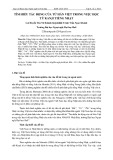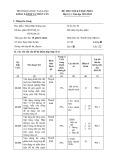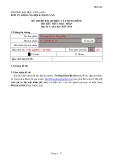
Japanese language learning motivation through interaction with native speakers: A case study*Nguyen Minh Hung and Ho Le Thi Xuan TrinhHong Bang International University, VietnamABSTRACTThe research aims at investigating social-psychological orientations of HIUJLLs (Japanese Language Department learners of Hong Bang International University). A survey and a semi-structured interview are governed by 68 students ranging from 2nd to 4th academic year with various Japanese levels from elementary to advanced. Besides, SPSS (Statistical Package for the Social Sciences) is employed to analyze the collected data by percentage, mean of frequency and standard deviation. As a result, the research reveals that participants are generally motivated at a very high level in interacting with native speakers both Japanese teachers and students. Also, students affirm that their learning with native speakers if well arranged and designed would result in intense motivation and inspiration for them to learn Japanese much harder. As a result, some recommendations are made for further preparation and arrangement of comprehensively structured settings for long-term interactions with native speakers in Japanese language teaching and studying methodology. Keywords: instrumental motivation, integrative motivation, language learning motivationThis research study purpose is to do a survey in to comprehend the effecveness of interacng with nave speakers, namely teachers, students and guests, in Japanese language learning movaon of HIUJLLs. As a subsequence, authors aspire to recommend adjustments in curriculum design, extra-curricular acvies and internaonal cultural exchanges with intensive nave speaker's interacons. Research subject is Japanese language learning movaon in interacng with nave speakers. Survey subjects HIUJLLs of K19, K20 & K21 as seniors, juniors and sophomores, respecvely those who have already had experiences in learning directly with Japanese teachers, engaging cultural exchanges and communicaon with Japanese students and guests during their study. The research study analyzes literature review on roles and significance of language learning movaon in interacng with nave speakers. 2. LITERATURE REVIEW2.1. Language Learning movaon: Definion and beyondThough the term “movaon” sounds brief and straighorward, its meaning has yet to be fully conveyed. According to Lightbrown and Spada [1], movaon in language learning is obvious as learners have communicave needs and atudes towards the target language community. Therefore, to sasfy such a need is a prerequisite in iniang an effecve language learning environment. Meanwhile, Harmer [2] defines movaon in learners' short-term goal and long-term one. For him, language learners always have two needs to meet; one is to earn a high score or to pass an exam and the other is the learner's desire to communicate with nave speakers of the target language or job opportunies in the future. Among definions of movaon from scholars, Garner [3] claims a clear definion of movaon as (1) desire to learn the language, (2) movaonal intensity and effort and (3) atude towards learning. He also said a truly movated learner must exemplify the three categories. Ames [4] reconfirmed the famous quote of US former Secretary of Educaon, Terrel Howard Bell by highlighng the significance of movaon when saying “There are three things to remember 53Hong Bang Internaonal University Journal of ScienceISSN: 2615 - 9686Hong Bang Internaonal University Journal of Science - Vol.4 - June 2023: 53-60DOI: hps://doi.org/10.59294/HIUJS.VOL.4.2023.386Corresponding Author: MA. Nguyen Minh Hung Email: hungnm@hiu.vn1. INTRODUCTION

54Hong Bang Internaonal University Journal of ScienceISSN: 2615 - 9686Hong Bang Internaonal University Journal of Science - Vol.4 - June 2023: 53-60about educaon. The first is movaon. The second one is movaon. The third one is movaon.” No need to say but through educaon we can recognize that students aspire to achieve skills and knowledge, so movaon becomes a key to recharge their energy and spirit to keep running in this learning process. In short, movaon is the crucial factor that puts learners always at ready step to move forward to their goal. 2.2. Classificaon of language learning movaonDifferent scholars might have various ways of seeing movaon in language learning; however, according to Ryan and Deci [5] and Passer and Smith [6], the essence of movaon can be interpreted into “intrinsic” and “extrinsic” values. While intrinsic ones refer to the learner's passion for language proficiency and self-determinaon, extrinsic ones encourage them to work harder for rewards and avoid punishment.Garner and Lambert [7] received popular acceptance from the academic community when aempng to categorize movaon into “integrave movaon” and “instrumental movaon”. This is in turn clarified by Saville-Troike in exemplifying extrinsic values by social interacons, during which language learners can communicate in targeted language with nave speakers to understand more about their culture and introduce our own culture with the outside world. Meanwhile, they state that intrinsic values are more concerned with praccal values such as geng a high score in class or passing an exam to climb higher in academics. 2.3. Interacng with nave speakers and language learning movaonSaville-Troike [8] argues that individual movaon is the key to ulmate achievement in language learning. The more movated a language learner is, the easier and faster he/she can become competent in the learning process. Also, he connued to claim that language learning movaon can be categorized into two types. One is “integrave movaon” which inspires learners to work harder to achieve such a language competence stage when they can comfortably communicate with nave speakers and enjoy the utmost sasfacon in comprehensive understanding and exploring mutual cultures, defining their values and earning respect and admiraon from the public. Another one is “instrumental movaon” which movates language learners in a more praccal orientaon. Such movaon prevails to push learners forward to aain higher test scores or pass the exam. The former one can be achieved through interacons with nave speaker teachers, students and visitors. Ellis [9] idenfies that learner's atudes can be shaped by external factors that in turn alter the way they approach their language learning. In parcular, learners are put into a context where they are supposed to communicate posively their learning text with a nave speaker, either their teacher or exchange student or a school visitor. In other words, if students are interested in the culture and the country of the language they are learning, definitely they would be inspired to learn that language beer. 2.4. Recent research related to language learning movaonSiriluck and Sirithip [10] conducted a research study on two groups of students whose language proficiency varies according to their difference in integrave movaon. The findings show that those who have higher integrave movaon seem to perform English beer than the other group. Also, they found a higher movaon among beer English performance. As a subsequence, this research finding reveals that those who have a strong integrave movaon in them would find approaches to improve their language proficiency so that they can sasfy preliminary needs in language acquision to achieve their targets such as communicaon in cultural exchanges, exploraon in lifestyles and meeng social expectaons.More recently, Tatjana, Carlos and Janos [11] implemented a research study to learn about movaons for learning Hungarian for internaonal students in Budapest, the capital city of Hungary. In-depth interviews were made to find out that both integrave and instrumental movaon inspired the students to study Hungarian. While many might see instrumental movaon could be short-term and might go down when language learners achieve the target they set up, it may not be true if combined with integrave movaon which push learners forward and connuously improve themselves to sasfy long-term needs in

55Hong Bang Internaonal University Journal of ScienceISSN: 2615 - 9686Hong Bang Internaonal University Journal of Science - Vol.4 - June 2023: 53-60language learning acquision. Regardless of the wealth of literature on language learning movaon, there is a dearth of praccal study on learning movaon from interacng with nave speakers in Japanese students. Therefore, this inspires me to do this research and find out more about movaonal orientaons of HIUJLLs through their expectaons and concerns about what might movate them in learning Japanese language as well as through interacve experiences they have had with nave speaker teachers, students and visitors both online and offline. 2.5. Research quesons1.How are HIUJLLs movated to learn the Japanese language? 2.Is the movaon in learning Japanese of students at HIU (Hong Bang Internaonal University) more integrave or instrumental? 3.What are their percepons of interacons with Japanese nave speaker teachers, students and visitors influencing their movaon to study Japanese?3. METHODOLOGY3.1. Research pacipantsThis study is implemented on 68 students ranging from 2nd year to 4th year students of the Japanese Language Department, Hong Bang Internaonal University. They are all Japanese majors and agree to aend this research project. Before doing the survey and aending semi-structured interviews, they are all informed about the purpose of their parcipaon and aware that the research result will serve for improving the curriculum, which would result in posive modificaon to the current curriculum. There are 3 classes with each of them consisng of approximately 30 students. K19 (senior) 25 students, K20 (junior) 32 students and K21 (sophomore) 30 students. They all started their learning at HIU at a comparavely lower entry level but with various learning movaons. 3.2. Research instrumentsThe data for this research study was gathered from a survey of 46 quesons covering 6 categories ranging from conveying parcipant's general informaon with 10 quesons, instrumental movaon 7 quesons, integrave movaon 5 quesons, interacon with nave speaker teachers 6 quesons, with nave speaker students 7 quesons, with nave speaker students online 7 quesons, with nave speaker visitor 4 quesons. The quesonnaire ulized a five-point Likert scale with responses set on a connuum from strongly agree to strongly disagree. In the first secon of the quesonnaire, 10 quesons focused on general informaon about the parcipant and if they are interested in interacng with nave speakers using the Japanese language. The second secon concentrated on instrumental movaon while the third one on integrave movaon. The next secon goes into details about whether students enjoyed past interacons with nave speaker teachers, students, visitors, and even online nave speaker students. Through the quesons, the research study is supposed to know more about the expectaons and concerns students have for interacons with nave speakers. The result promises to bring to teachers and administrators a lot of pedagogical and administrave discussions for the sake of student's benefits from interacng with nave speakers. 3.3. Data analysisSPSS (Stascal Package for the Social Sciences) was used to analyze the data in this research. In the first place, sample responses were coded as numerical data. In parcular, “strongly agree” is named as 5, “strongly disagree” numbered as 1, with 4, 3, 2 in the middle. Descripve stascs were used to calculate the mean and standard deviaon of the parcipant selecons. The closer the response means are to 1, the lower the student's agreement with the statement. As a result, respondents with a mean of 3.68 or higher were categorized as high-movaon learners while between 2.34 & 3.67 as medium-movaon learners and finally between 1 to 2.33 as low-movaon ones. Eventually, based on the research findings the author formed a conclusion and offered some recommendaons for changes in curriculum as well as teaching methodology so that they can bring to students the most movaons for their learning Japanese beer. 4. RESULT AND DISCUSSION4.1. Rearch findings from survey4.1.1. Student's image and inial movaon and interest in learning Japanese in the first placeMore females than male students parcipate in

the survey. They are majoring in Japanese Language Studies and have a definite strong passion for communicang with Japanese people, ranging from their own teacher, students and visitors. Almost 100% of their responses to the queson if they like to interact with nave speakers is yes. The reasons for their aspiraon for communicang with Japanese people range from their very preliminary need for praccing pronunciaon with nave speakers, learning new things from their counterparts to geng to know more about each other and upgrading knowledge. I am surprised to find out that their desire in learning Japanese comes from within themselves rather than the outside world. Parcularly, I find it very astonishing to learn that they mostly state their learning movaon comes from the surroundings and their own ability rather than from their teacher. 4.1.2. HIUJLLs' instrumental movaon in language learningThe result shows that students have quite high instrumental movaon for learning Japanese, with an average mean score of 4.09. It is obvious that students think very praccally about their study at the university. For them, to study well means to promise a good cerficaon from the society as well as an easier way to find a highly paying job. For them, to be admired with good Japanese knowledge or to please teachers and compete with classmates is not that important, though quite many of them admit that they would like to please their parents about their study result. 4.1.3. HIUJLLs'integrave movaon in language learningThe respondents had a very high level of integrave movaon for Japanese learning with a total mean score of 4.77. They were smulated by the capability of introducing Vietnamese culture to Japanese people. Also, they affirm that a high ability in Japanese enables them to explore Japanese culture, communicate with nave speakers and comfortably join interacve acvies with nave speakers. Besides, they do not forget to confirm that a high capability in Japanese enables them to enjoy manga, Japanese music and films.Table 1. HIUJLLs reveal their instrumental movaon56Hong Bang Internaonal University Journal of ScienceISSN: 2615 - 9686Hong Bang Internaonal University Journal of Science - Vol.4 - June 2023: 53-60
No.
Statements
N = 68
Motivation level
M
SD
Item 1
Study Japanese well to graduate
4.78
0.41
High
Item 2
Study Japanese well to easily find a good job with high pay.
4.61
0.42
High
Item 3
Speaking Japanese well can make people admire me.
3.65
0.88
Medium
Item4
Using Japanese well makes people highly evaluate me as an erudite.
4.14
0.92
High
Item 5
I must study Japanese well to meet my family’s expectations.
4.05
0.86
High
Item 6
I must study Japanese well to please my teachers.
3.68
0.89
Medium
Item 7
I don’t want to be inferior to my classmates.
3.78
0.90
Medium
Overall
4.09
0.75
High

57Hong Bang Internaonal University Journal of ScienceISSN: 2615 - 9686Hong Bang Internaonal University Journal of Science - Vol.4 - June 2023: 53-604.1.4. HIUJLLs'movaon in interacng with nave speaker teachersStudents share their posive experiences learning with Japanese teachers (N=4.87). For them, a teacher's posive atude, acve learning environment and effecve teaching methodology would result in the success of learning with Japanese teachers. If that is the case then it would turn in their higher movaon to learn Japanese more at home such as improving their vocabulary, kanji and grammar and encouraging them to read newspapers, watch movies and do homework assignments in Japanese more.4.1.5. HIUJLLs'movaon in interacng with nave speakers studentsLike interacng with nave Japanese teachers, communicang and learning with Japanese students through exchange programs bring students with a lot of opportunies to improve their Japanese language proficiency as Vietnamese students highly evaluate that Japanese friends are very friendly and posive in teaching them Japanese (N=4.39). As a consequently, they state in the survey that they would like to have more interacons with Japanese students and that they should be in a long-term exchange program so that they can have more communicaons both inside and outside of the classroom. However, from the result table we can also see that students sll feel that their lack of Japanese proficiency also interferes with their success interacng with Japanese nave students. They said that the more they have me for each other the more they can get to know each other beer and that would lead to their more interest in learning from each other and become a great movaon for their learning Japanese. 4.1.6. HIUJLLs'movaon in interacng with nave speakers students via online approachStudents show their hesitaons in com-municang with Japanese students online as Internet connecon plays an essenal role in determining its success (N=3.47). From their past experiences, internet connecvity got lost too oen that intervened into smoothness of their interacons. Although they sll highly evaluate such interacons with Japanese friends posively and describe that their Japanese counterparts are so nice, a frequent loss in internet connecvity as well as a lack of structured program of interacon oen result in posive feedback from those who can interact well with Japanese students while negave one from those le behind. As a result, they recommend that interesng topics with good preparaon together with smooth internet connecvity would determine its success.Table 2. HIUJLLs show their integrave movaon
No
Statements
N = 68
Motivation level
M
SD
Item 1
Fluency in Japanese enables me to introduce Vietnamese culture to Japanese people.
4.68
0.74
High
Item 2
Fluency in Japanese enables me to explore Japanese culture
4.80
0.88
High
Item 3
Competent in Japanese makes me communicate with native speakers more easily
4.89
0.41
High
Item 4
Being good at Japanese makes me join interactive activities with native speakers more easily
4.90
0.38
High
Item 5
Being fluent in Japanese makes me enjoy manga, Japanese music and films more comfortably
4.60
0.48
High
Overall
4.77
0.57
High


![Đề thi Ngữ pháp tiếng Nhật 3 (kì 1 2021-2022) có đáp án [kèm đề thi]](https://cdn.tailieu.vn/images/document/thumbnail/2025/20250409/gaupanda086/135x160/9981744185437.jpg)

![Đề thi Tiếng Nhật IT học kì 1 năm 2023-2024 có đáp án [Mới nhất]](https://cdn.tailieu.vn/images/document/thumbnail/2025/20250210/gaupanda073/135x160/8311739169576.jpg)



![Đề thi Tiếng Nhật 4 học kì 2 năm 2023-2024 (có đáp án) - [Kèm đề thi kết thúc học phần]](https://cdn.tailieu.vn/images/document/thumbnail/2025/20250206/gaupanda072/135x160/1461738814500.jpg)
![Đề thi Tiếng Nhật 1 học kì 2 năm 2023-2024 có đáp án [kèm đề thi]](https://cdn.tailieu.vn/images/document/thumbnail/2025/20250206/gaupanda072/135x160/7661738814508.jpg)


![Tài liệu Ngữ pháp HSK 3 [chuẩn nhất/ đầy đủ/ chi tiết]](https://cdn.tailieu.vn/images/document/thumbnail/2025/20251108/yenlethingoc49@gmail.com/135x160/11711762589284.jpg)


![Bài giảng Tiếng Trung Quốc du lịch khách sạn [Tập hợp]](https://cdn.tailieu.vn/images/document/thumbnail/2025/20251003/kimphuong1001/135x160/7291759464952.jpg)
![Đề thi Tiếng Trung 1 học kì 2 năm 2024-2025 có đáp án (Đề 2) - [Tuyển tập đề thi]](https://cdn.tailieu.vn/images/document/thumbnail/2025/20250920/kimphuong1001/135x160/76371758358928.jpg)

![Tài liệu Ngữ pháp HSK 2 [mới nhất]](https://cdn.tailieu.vn/images/document/thumbnail/2025/20250916/thanhhoa.lda@gmail.com/135x160/3241757994918.jpg)

![Đề thi Tiếng Trung 1 học kì 2 năm 2024-2025 có đáp án (Đề 1) - [Tuyển tập]](https://cdn.tailieu.vn/images/document/thumbnail/2025/20250823/kimphuong1001/135x160/95221755919445.jpg)





